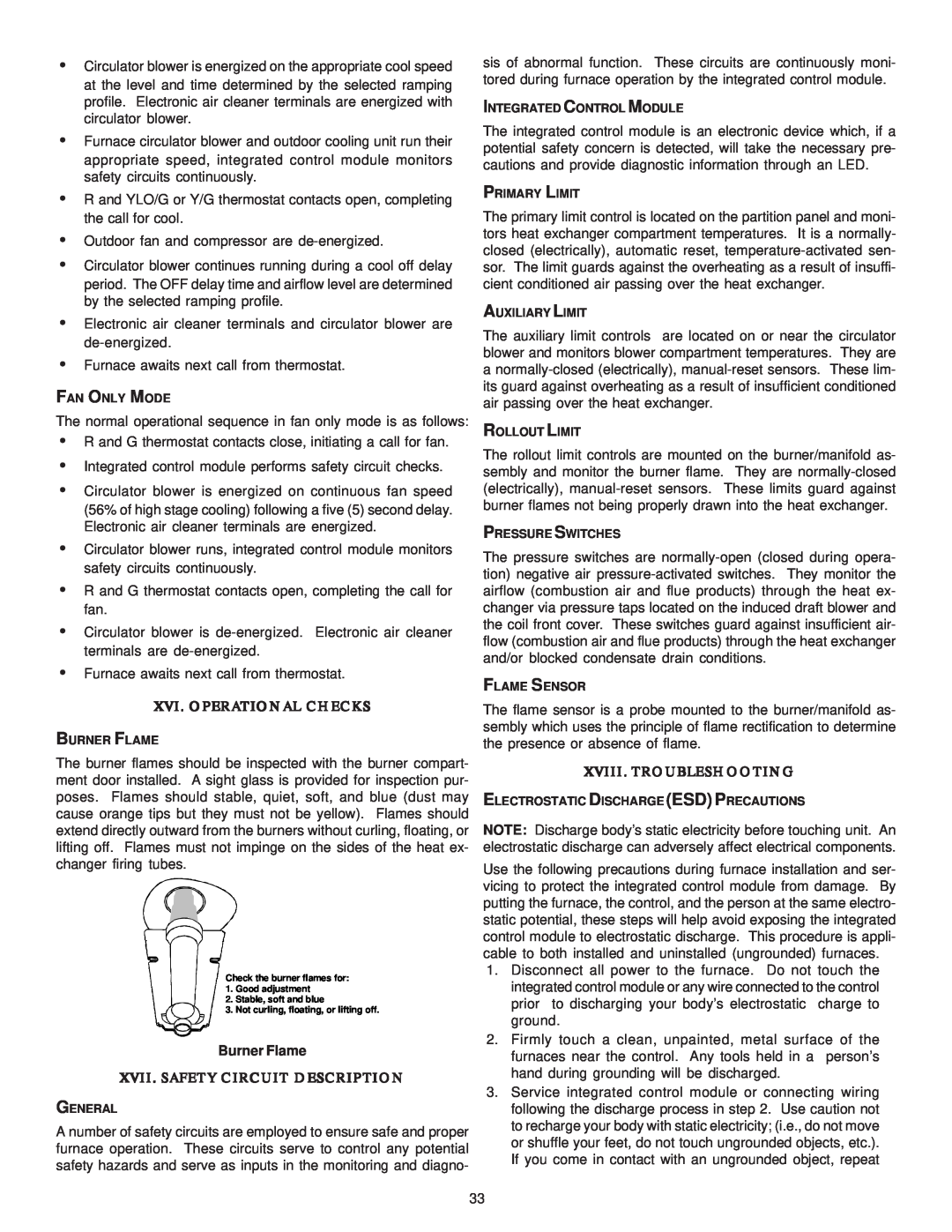
•Circulator blower is energized on the appropriate cool speed at the level and time determined by the selected ramping profile. Electronic air cleaner terminals are energized with circulator blower.
•Furnace circulator blower and outdoor cooling unit run their
•
•
•
•
•
appropriate speed, integrated control module monitors safety circuits continuously.
R and YLO/G or Y/G thermostat contacts open, completing the call for cool.
Outdoor fan and compressor are
Circulator blower continues running during a cool off delay period. The OFF delay time and airflow level are determined by the selected ramping profile.
Electronic air cleaner terminals and circulator blower are
Furnace awaits next call from thermostat.
FAN ONLY MODE
The normal operational sequence in fan only mode is as follows:
•
•
•
R and G thermostat contacts close, initiating a call for fan. Integrated control module performs safety circuit checks.
Circulator blower is energized on continuous fan speed (56% of high stage cooling) following a five (5) second delay. Electronic air cleaner terminals are energized.
•Circulator blower runs, integrated control module monitors safety circuits continuously.
•
•
R and G thermostat contacts open, completing the call for fan.
Circulator blower is
• Furnace awaits next call from thermostat. | FLAME SENSOR |
|
XVI. OPERATIONAL CHECKS | The flame sensor is a probe mounted to the burner/manifold as- | |
BURNER FLAME | sembly which uses the principle of flame rectification to determine | |
the presence or absence of flame. | ||
The burner flames should be inspected with the burner compart- | XVIII. TROUBLESHOOTING | |
ment door installed. A sight glass is provided for inspection pur- | ||
| ||
poses. Flames should stable, quiet, soft, and blue (dust may | ELECTROSTATIC DISCHARGE (ESD) PRECAUTIONS | |
cause orange tips but they must not be yellow). Flames should | NOTE: Discharge body’s static electricity before touching unit. An | |
extend directly outward from the burners without curling, floating, or | ||
lifting off. Flames must not impinge on the sides of the heat ex- | electrostatic discharge can adversely affect electrical components. | |
changer firing tubes. | Use the following precautions during furnace installation and ser- | |
| vicing to protect the integrated control module from damage. By | |
| putting the furnace, the control, and the person at the same electro- | |
| static potential, these steps will help avoid exposing the integrated | |
| control module to electrostatic discharge. This procedure is appli- | |
| cable to both installed and uninstalled (ungrounded) furnaces. | |
Check the burner flames for: | 1. Disconnect all power to the furnace. Do not touch the | |
integrated control module or any wire connected to the control | ||
1. Good adjustment | ||
2. Stable, soft and blue | prior to discharging your body’s electrostatic charge to | |
3. Not curling, floating, or lifting off. | ||
ground. | ||
|
Burner Flame
XVII. SAFETY CIRCUIT DESCRIPTION
GENERAL
A number of safety circuits are employed to ensure safe and proper furnace operation. These circuits serve to control any potential safety hazards and serve as inputs in the monitoring and diagno-
33
